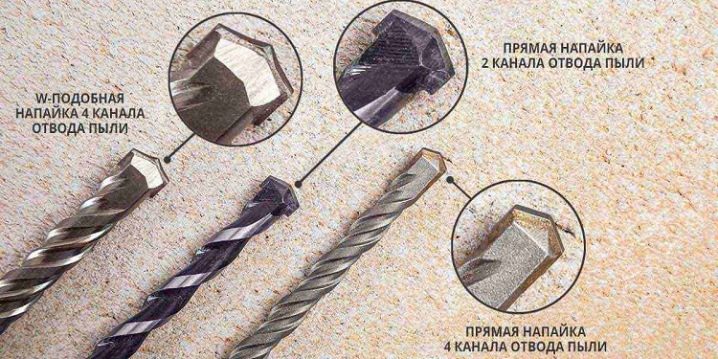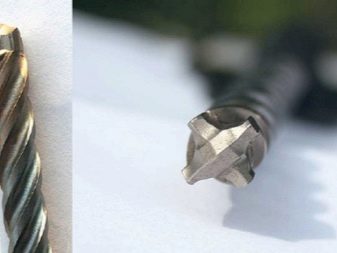Hammer drill bits: types, sizes and tips

Drill or drill - this question will be answered very easily by an experienced specialist engaged in finishing, repair and construction work. It's all about the scale of the task. A hammer drill is an electromechanical tool in which the consumable replaceable part performs rotational and percussion movements. The mode is selected depending on the purpose, the main purpose is to create holes. It can be used for interior decoration or as a simple jackhammer for punching various structures.
It differs from the hammer drill in the pneumatic principle and the more powerful electric motor, which creates much more production possibilities while reducing the working time. The drill is a working impact-cutting replaceable part.

Peculiarities
A hammer drill is not a drill, although they look very similar in appearance. Fundamental differences of the first: tail end, more durable material, a larger range of sizes. The shank is the part that fixes and is firmly fixed in the chuck of the rock drill. For drills, such a device is not provided. Construction classics claim that a drill is a consumable that no longer improves. Perhaps that is why the sale is carried out as part of sets "for all occasions."
In order for the tool to serve well and for a long time in harsh operating conditions, it is necessary to use a special lubricant. It is applied prior to use on both the hammer chuck and the shank of the replacement part.

Views
Boers are of various types. Specimens for metalwork are not very effective for use on the ground, a good option for wood is not very suitable for work on tiles. The differentiating criterion can be not only the quality of the metal or alloy, but also the design features. Auger is a self-sharpening "worm gear" option used when working at great depths of drilling. It removes the formed crumbs well, is "hardy", more durable in conditions of severe exploitation.

It is customary to classify percussion-cutting consumable tools into several types.
- Like a regular drill - good for creating cylindrical holes.
- Pica - used in concrete operations. Serves as an "electric hammer" to create wide holes.
- Chisel - suitable for materials to be dismantled. For example, when dismantling tiles or old plaster.


- Crown - this type is used to solve specific problems, for example, when preparing for the installation of electrical outlets. The purpose is to create deep holes of the correct shape. The creation of wide openings for the routing of water pipes is another typical application.
- Wood use exceeds the efficiency of the use of similar drills at times. The working forces are reduced, the chips are separated faster, the structure of the wood under such a cutter does not collapse.
- Earth and construction drill Are different production themes for a similar design. The first one is applicable not only with a motor, but also in a manual version, with a drive of human muscular strength, since it does not require a high intensity of rotation.



Dimensions (edit)
Length and diameter are also important differences. For purely domestic work, products with diameters in the range from 6 to 10 millimeters are applicable. The dowel must comply strictly.A prerequisite for securing large objects is a long drill and a 20 mm diameter. The maximum cross-sectional diameter can be up to 5 centimeters. The length of the product is 10, 50, 80 or even 100 centimeters, depending on the thickness of the punching material.


An idea of the possibilities of a sample is given by the marking, which is applied by any self-respecting manufacturer. For example, a combination of numbers 6.5x160 indicates a diameter of 6.5 mm and a length of 160 mm. Other dimensional options are the same. The manufacturer combines the length with the diameter so that the tool works efficiently and for a long time.


Selection criteria
The set of criteria for choosing a household or industrial product is very diverse. The basic requirement is a confident solution to the problem of overcoming the hardness of the material. The second question is the choice of the optimal solution based on price and quality. Here, as in other market cases, you need to be wary of fakes and not expect miracles from copies in a low price category. A good supplier naturally values itself, but that doesn't mean it isn't being counterfeited. A cheap copy may be a tool only for a one-time job.
The authority, or at least the fame of the manufacturer, is the rule for choosing. It is important that in the course of further operation the hammer drill is not damaged. There are some products that, in general, should not be inserted into the cartridge. Better not to chase too much the lowest price and be reinsured.



Manufacturers such as Makita, Sturm or Bosch are among the most sought after. They do not need special recommendations, but you should pay attention to the manufacturing plants of the same company. Unfortunately, products of the same brand made in different countries can vary in efficiency and durability.
The most expensive segment is intended for professionals; for home use, marked parts in the middle price category are quite suitable. The quality of the material determines the range and potential resource of use. When choosing a purchase target, be sure to take into account the design of the tail section, which is fixed.
It is customary to divide shanks into different types according to a special fastening system. SDS and SDSplus are the most demanded for medium and low power with a cutting tool diameter of 10-18 millimeters, the length of the fixed part is 4 centimeters. SDStop is used when the drill bit is 14 millimeters in diameter.



SDSmax applies to more powerful devices, the depth of the fastener here is 9 centimeters, and the diameter is from 18 millimeters. SDSquick is a Bosch design for a "tail" in a hexagonal section that provides a tight and secure fit in conditions of increased stress and vibration. When choosing a consumable by the type of shank, you must first look at the instruction manual for the hammer drill. The manufacturer usually specifies this parameter accurately.
In some cases, an extension cord will be required to solve a production problem. It extends the drilling length without changing the hole diameter. It is very important when using crowns or in the process of excavation. One desired piece can be supplemented with a set of rods of various lengths, which increases production capabilities. For example, specialists who drill in the ground using a gasoline or electric motor can thus deepen up to one and a half to two meters.


How to use?
Always make sure that there is no damage before using it and clean the instrument if necessary. After that, lubricate the rubbing parts, then with some effort insert the drill with the shank into the chuck. A click can be considered a signal of correct action. A control attempt to unsuccessfully pull the drill back is for insurance.
After finishing work or to replace the drill, it is required to press the chuck ring in the direction of the tool along the axis, after which you can expect the extraction to work. Unfortunately, in practice, there are times when this does not happen. This is typical if the shank was deformed during operation. One of the possible reasons is the poor quality of the metal under excessive pressure during the working operation. Lack of lubrication provokes this matter even more, because the tool heats up.


Practitioners suggest using a vise, where the drill is clamped, and the hammer is pulled out with swinging from side to side. In this case, the cartridge is in a strictly open position. Be that as it may, the consumable is no longer usable. If this does not help, clamp the hammer in a vise using shims to prevent damage to the case. A stuck drill is also crimped with a gas wrench, which plays the role of a lever. A few hammer blows on the key will show how futile hopes are. If success is not achieved, you will definitely have to disassemble the puncher, for which it is better to contact a regular service center.
If the interchangeable tool is jammed directly in the structure, switch to impact mode. Further, by pulling with a twitch on yourself, you can try to achieve success by understanding the cause of the jam. The worst option is when a stuck consumable item is simply cut off with a grinder.



Sometimes the user is faced with a different kind of trouble - the drill flies out of the cartridge. The phenomenon does not allow high-quality work and threatens safety. This may be due to prolonged tilting operation, a defective consumable, or wear on the locking mechanism. If the matter is not in the storm and the conditions of its use, the repair of the rock drill can be assessed as a sudden task that has arisen. Is it possible to sharpen a drill - beginners are constantly talking about this.
Sharpening is possible in principle, but the effectiveness of this work is very controversial:
- an appropriate industrial tool is needed for the operation;
- an experienced master is needed.
Before making a decision, the user must estimate how much such work will cost in comparison with the price of a new product. In industrial versions on construction sites, the drills are simply replaced, because the developer considers the benefits.


Advice
A quickly broken copy will be very upsetting, so it should only be used within its acceptable range of capabilities. Basic requirement: the harder the drilling material, the harder the tool tip material. Experts recommend using VK8 or VK8 alloy - a technology with a high tungsten content. Auger structures tend to "live" longer. The drill should not be forcibly inserted into the drill chuck, nothing good will come of it for sure. This is an option for a completely different design and power.
It is generally accepted that the more the spiral is twisted, the higher the rotation speed should be. A deeper hole is made in the same time. In any case, the recommended operating speeds should be used. The drilling axis should not change during the process as this creates a potential deformation hazard.
In the event that it is necessary to drill on concrete with reinforcement, the tip must be diamond-coated or consist of an alloy for which both concrete and metal are of no concern. No matter how the circumstances evolve in the course of the task, you should never forget about security measures. This is where the future success or failure of the operation always begins. Small holes are made with products where the spiral is flatter. In general, before starting, you need to clearly understand what kind of tool you need. Excessive effort does not improve the quality of the workflow. Any deformation makes the device unsuitable for use, including for safety requirements.


Thus, choosing and using a drill is not too difficult a task, even for a layman.The main thing is to follow the technical specifications and not put experiments at the expense of safety.
For information on how to sharpen a drill for a hammer drill, see the next video.













The comment was sent successfully.